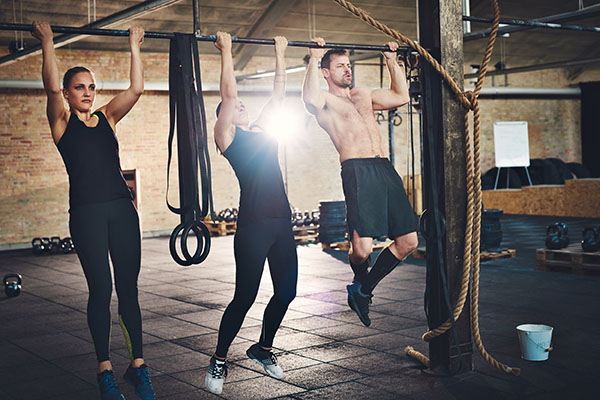MADE IN THE USA | NATURAL, NON-GMO, DAIRY FREE & GLUTEN FREE | FREE SHIPPING IN THE USA
Do pull ups help increase height?
Here’s why: your height is locked in by your growth plates, also known as the epiphyseal plates. These plates are soft during childhood and adolescence and allow bones to lengthen. But once they fuse—usually around 16–18 for females and 18–21 for males—it’s game over. You can train all you want, hang from a bar until your hands blister, but you’re not adding bone length once those plates are closed.
Pull-Ups: What Muscles Do They Work?
Pull-ups hit almost every major muscle group in your upper body—but they don’t just build strength. They also play a surprising role in helping you stand taller by reinforcing posture and supporting spinal alignment.
Here’s what’s really going on when you do a pull-up: the latissimus dorsi (those wide V-shaped muscles along your back) handle most of the heavy lifting. Your trapezius helps pull your shoulders down and back, while your scapular stabilizers and core muscles keep your entire frame tight and controlled. That level of activation isn't just good for strength—it directly supports a more upright, extended posture.
During the upward pull (the concentric phase), your arm flexors and shoulders drive the motion. But it’s the eccentric phase—lowering slowly back down—that really builds control and flexibility in the back. That’s where you train the small stabilizers around your spine and scapula, which quietly shape how you carry yourself. And posture? That’s where perceived height lives or dies.

Can Pull-Ups Really Increase Your Height?
No, pull-ups won’t actually make you taller permanently— but they can help you appear taller if you know what’s really going on under the surface. When you hang from a bar, your spine experiences a bit of a break from gravity. This causes a small spine decompression effect, especially between your intervertebral discs, which can slightly stretch the spine and give you a temporary height boost—sometimes as much as 1 to 2 cm, depending on posture and flexibility. But here’s the catch: that “gain” usually fades within an hour or two once gravity pulls you back into compression mode.
The real benefit of pull-ups has less to do with bone growth and more to do with postural improvement. Think about how much space bad posture eats up—rounded shoulders, slumped spine, forward head tilt. Now picture what happens when you strengthen your back muscles, especially the latissimus dorsi, and straighten your spinal alignment. That subtle change in vertebral positioning creates a noticeable difference in how tall you look, even though your bones haven’t grown. That’s the height illusion many people notice after doing pull-ups regularly.
What Pull-Ups Actually Do for Your Height Appearance
-
Stretch the spine temporarily, reducing gravitational compression.
-
Improve posture, making you stand straighter and appear taller.
-
Support spinal alignment and reduce postural imbalances over time.
It doesn’t matter if you’re a teenager looking for growth hacks or someone in their 30s trying to reclaim posture—pull-ups grow taller illusions, not inches. If you’ve ever stood taller after a long stretch or hanging from a bar, you’ve felt this effect in action. And for people who sit a lot, even just feeling a little taller can be a game-changer for confidence.
How Posture Affects Perceived Height
Here’s the truth most people miss: you might already be “tall enough”—you’re just not standing tall. A slouched posture can rob you of up to 2 inches of visible height. That’s not theory—it’s something I’ve seen over and over again in clients who thought they’d plateaued. Once we fixed their alignment, the difference was obvious: longer neck line, better spine stacking, and that confident upright presence that makes people think, “This guy looks taller.”
Posture and height perception go hand in hand. Especially with digital life pulling our shoulders forward and flattening out our lower backs, a lot of people develop kyphosis or that classic forward-leaning hunch. Pull-ups—when done right—are one of the simplest ways to reverse that. They help reset your spinal curvature, strengthen postural muscles, and bring back body symmetry. It’s not about chasing inches—it’s about unlocking what’s already there.
Pull-Ups: A Surprisingly Effective Posture Fix
What makes pull-ups so powerful for posture correction? It comes down to three things:
-
They decompress the spine—especially with dead hangs or wide-grip pulls.
-
They train the posterior chain—which pulls your shoulders back and opens up your chest.
-
They build deep core stability—which helps keep your spine aligned while standing or walking.
Most people don’t think of pull-ups as posture exercises, but in my two decades coaching posture-challenged athletes and late-growth seekers, I’ve found they outperform most “corrective” drills—if your form is solid.
Let me give you an example. A 22-year-old guy I worked with had about 1.5 inches of what I call "postural compression"—his height didn’t reflect his skeletal structure. After 6 weeks of progressive pull-up work and neutral spine awareness drills, his visual height changed immediately. He looked leaner, taller, and his clothes fit better. No growth spurt needed.
Pull-Ups and Spinal Decompression: Temporary Height Gains?
Let’s clear the air on something I’ve tested myself — hanging can make you taller… but just for a little while. The mechanism behind it is simple: gravity pulls your spine downward, opening up the intervertebral space between your vertebrae. That slight decompression — even if it’s just a few millimeters — can give you a visible height boost, especially right after you get off the bar. Most people don’t realize how compressed their spine gets during the day. You’ll stand taller just by undoing that.
Spinal decompression through pull-ups, hanging therapy, or inversion tables isn’t new — but it’s having a moment again. And for good reason. When done right, you can gain anywhere from 1 to 2 cm right after a hanging session. I’ve seen it myself dozens of times in people tracking their morning versus evening height. The science backs it too. A 2023 clinical review showed that short bursts of decompression exercises increased measured height in the short term, with a mean gain of 1.3 cm after 10 minutes of inversion. That may not sound like much, but it’s enough to square your posture, extend your frame, and turn heads.
What’s Really Happening When You Hang?
The secret is all about tension relief and spinal fluid redistribution. Here’s what’s going on inside your spine during a hang:
-
Gravity pull stretches your spine downward, creating space between vertebrae.
-
Spinal fluid and soft tissue adjust, letting your discs rehydrate and expand.
-
Tension melts from the lower back and shoulders — even your hips decompress a bit.
But here’s the kicker — it doesn’t last. As soon as you’re back on your feet for a few hours, that extra space starts shrinking again. It’s a fluid shift, not bone growth. So if you're hoping for a permanent few inches, this isn’t your golden ticket. But if you want to look taller now? You’re in the right place.
How to Use Hanging for Height Optimization
If you’re just starting, begin small:
-
Hang from a bar for 30–60 seconds, 2–3 times a day.
-
Morning sessions are ideal — your discs are already slightly decompressed from sleep.
-
Combine with deep breathing to relax your spine and boost results.
Advanced folks — you know who you are — can use gravity boots or inversion tables to go deeper. These aren’t just gimmicks. When used consistently (3–5 times a week), they can help maintain your tallest posture and retrain your spinal alignment. In my experience, nothing compares to the feeling of stepping off an inversion rack and realizing your back just “clicked” into a taller version of yourself.

What Pull-Ups Are Actually Good For (And It’s Not Height)
Let’s get one thing straight—pull-ups aren’t going to make you taller. If you’ve been doing sets every morning hoping to add a couple inches to your frame, you’re not alone. A lot of people confuse spinal decompression with bone growth. But here’s the truth: pull-ups work wonders for your body—but not your height.
Now, that doesn’t mean they’re not worth doing. Far from it. Pull-ups are one of the most powerful exercises for building upper body strength, improving posture, and enhancing shoulder mobility. If your goal is to look taller, straighter, and stronger, pull-ups are your ally. They target your lats, traps, arms, and core—muscles that help open up your chest and pull your shoulders back. That alone can make you appear up to 1.5 to 2 inches taller, just by correcting your alignment.
Even if height growth is your priority, it’s a mistake to ignore pull up training benefits. Why? Because body control, joint health, and strength are part of the foundation. These are the traits that hold your frame together when you're doing inversion, hanging stretches, or any mobility work. In other words—they support the process, even if they don't directly trigger growth.
Why Do Pull Ups? The Metabolic and Mental Edge
Here’s something most people don’t talk about when it comes to pull-ups—they’re not just about strength. They change how your body functions. Every controlled rep sends a message to your central nervous system. Your heart rate climbs. Your metabolic engine fires up. And behind the scenes, hormones like testosterone and growth hormone start working harder.
In a 2024 study published in the Journal of Applied Physiology, researchers found that full-body calisthenics movements—pull-ups included—increased resting metabolic rate by 11% over six weeks in untrained adults. More interestingly, participants also reported better focus, less fatigue, and improved sleep—all indirect boosters of recovery and hormone regulation.
Pull-ups also give you a kind of grit you can't fake. Whether you're learning your first strict rep or adding weight to your set, there's a mental clarity that comes from pushing your body through that controlled discomfort. It’s not just about reps—it’s about resilience.
Here’s what happens when you start including pull-ups in your weekly routine:
-
Posture improves, especially if you work at a desk all day
-
Grip strength increases, which helps with everything from lifting weights to decompressing your spine
-
Upper body definition sharpens, especially in the back, shoulders, and arms
So, while pull-ups won’t stretch your bones or magically make you taller, they build the physical structure and mindset that support growth. And if you're serious about height optimization, you'll want every advantage you can get—starting immediately.
Final Verdict: Do Pull-Ups Help You Grow Taller or Not?
Let’s cut to the chase—pull-ups won’t make you taller. That idea’s been floating around gym locker rooms, Reddit threads, and TikTok reels for years. But no matter how many reps you knock out or how long you hang from the bar, your bones won’t lengthen. Once your growth plates close (which usually happens in your late teens to early 20s), that window shuts for good. No stretch, no supplement, no bar work will crack it back open.
Now, before you ditch pull-ups altogether, here’s the twist: they can still help—just not in the way you think. While they don’t extend your height in centimeters, they can improve how tall you look. Better posture, stronger back muscles, and spinal decompression make a surprising visual difference. Some folks gain up to 1–1.5 cm of apparent height just by fixing their posture. That’s not magic—it’s physiology.

